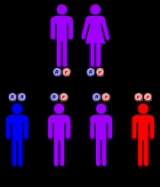
Argininemia
Overview
Recessive
In genetics, the term "recessive gene" refers to an allele that causes a phenotype that is only seen in a homozygous genotype and never in a heterozygous genotype. Every person has two copies of every gene on autosomal chromosomes, one from mother and one from father...
urea cycle disorder
Urea cycle disorder
An urea cycle disorder or urea cycle defect is a genetic disorder caused by a deficiency of one of the enzymes in the urea cycle which is responsible for removing ammonia from the blood stream. The urea cycle involves a series of biochemical steps in which nitrogen, a waste product of protein...
where a deficiency of the enzyme arginase
Arginase
Arginase is a manganese-containing enzyme. The reaction catalyzed by this enzyme is: arginine + H2O → ornithine + urea. It is the final enzyme of the urea cycle.- Structure and function :Arginase belong to the ureohydrolase family of enzymes....
causes a build up of arginine
Arginine
Arginine is an α-amino acid. The L-form is one of the 20 most common natural amino acids. At the level of molecular genetics, in the structure of the messenger ribonucleic acid mRNA, CGU, CGC, CGA, CGG, AGA, and AGG, are the triplets of nucleotide bases or codons that codify for arginine during...
and ammonia
Ammonia
Ammonia is a compound of nitrogen and hydrogen with the formula . It is a colourless gas with a characteristic pungent odour. Ammonia contributes significantly to the nutritional needs of terrestrial organisms by serving as a precursor to food and fertilizers. Ammonia, either directly or...
in the blood
Blood
Blood is a specialized bodily fluid in animals that delivers necessary substances such as nutrients and oxygen to the cells and transports metabolic waste products away from those same cells....
.
Ammonia, which is formed when proteins are broken down in the body, is toxic if levels become too high. The nervous system is especially sensitive to the effects of excess ammonia.
Argininemia usually becomes evident by about the age of 3.
Discussions

